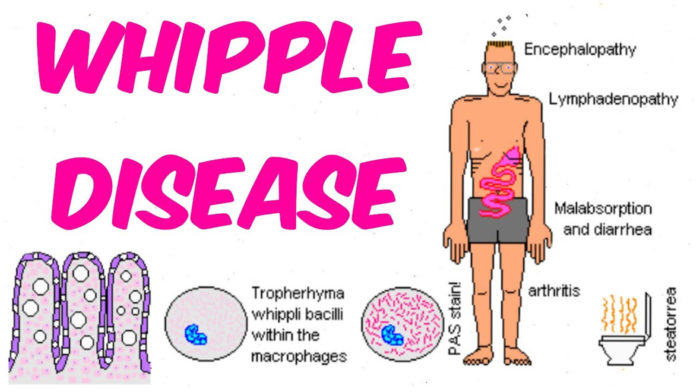Whipple disease is a rare bacterial infection that interferes with the body’s ability to process nutrients. The disease usually occurs in the gastrointestinal system, particularly the small intestine, but it can affect these other parts of the body:
- Eyes
- Heart
- Lungs
- Joints
- Central nervous system (the brain and spinal cord)
- Nerves throughout the body
Causes and Risk Factors of Whipple Disease
The review also cites recent data that suggests T. whipplei has been detected in Europe in 1.5 to 4 percent of fecal samples from asymptomatic people in the general population compared with as many as 12 to 25 percent of samples taken from sewage workers, people infected with HIV, and those experiencing homelessness, indicating that these groups have a higher risk of developing Whipple disease when exposed to the bacteria.
How Is Whipple Disease Diagnosed?
Initial assessments may involve:
- Blood tests to check for anemia, abnormal electrolyte levels, liver function, and nutrient malabsorption
- Blood tests for inflammatory joint disease if you have joint aches or swelling
- Stool studies if you have diarrhea
- Gastrointestinal endoscopy (a procedure in which the intestines are viewed using a lighted, flexible tube)
A definitive diagnosis of Whipple disease requires a biopsy of an affected organ — in which a tissue sample is viewed under a microscope — as well as a PCR (polymerase chain reaction) test on the tissue. Depending on the results of your exam and tests, your doctor may refer you to a gastroenterologist, a doctor who specializes in digestive diseases.
Prognosis of Whipple Disease
Treatment and Medication Options for Whipple Disease
Doctors may also recommend a diet that’s high in calories and protein to make up for the malnutrition commonly experienced by people with Whipple disease.
Medication Options
- ceftriaxone
- meropenem (Merrem)
- penicillin G
- streptomycin
After this initial treatment, you'll have to take oral antibiotics for one to two years to make sure your body is clear of T. whipplei. These medications may include the following:
- trimethoprim with sulfamethoxazole (Septra, Bactrim), a combination antibiotic
- doxycycline (Vibramycin)
Prevention of Whipple Disease
At this time, doctors do not have a way of preventing Whipple disease.
Research and Statistics: Who Has Whipple Disease?
The use of PCR testing as a tool to diagnose Whipple disease has made it possible for scientists to identify cases of Whipple disease that may have been previously missed.
Some noteworthy facts and numbers about Whipple disease:
- People of any age can get Whipple disease, but symptoms typically begin between age 30 and 60.
- The median age of diagnosis is 56.
- Whipple disease is more common in men — 4 times as many men get this illness compared with women.
Related Conditions of Whipple Disease
A number of conditions have symptoms and signs that are similar to those of Whipple disease:
- Crohn’s Disease This inflammatory bowel disease causes chronic inflammation of the gastrointestinal tract. Symptoms can include diarrhea, blood in the stool, fever, weight loss, and abdominal pain.
- Ulcerative Colitis Another type of inflammatory bowel disease, ulcerative colitis can lead to diarrhea, bloody stools, and abdominal pain. Other symptoms include cramping and an urgent need to empty the bowels.
- Rheumatoid Arthritis This autoimmune disorder causes joint stiffness, weakness, fatigue, and painful swelling in the joints.
Resources We Love
National Organization for Rare Disorders (NORD)
This site is a go-to source for information on disorders that are not common but can profoundly affect individuals who are affected by them. From facts about symptoms and causes to who might be affected and which latest treatments might be right and why, NORD, which also provides links to other resources, is a good place to start to get more information about Whipple disease.
National Institute of Neurological Disorders and Stroke (NINDS)
In addition to helpful information about Whipple disease, such as symptoms, treatment, and prognosis, the NINDS website also links to clinical trials related to this rare disease.
Additional reporting by Joseph Bennington-Castro.
Editorial Sources and Fact-Checking
- Whipple’s Disease Information Page. National Institute of Neurological Disorders and Stroke. March 27, 2019.
- Whipple Disease. National Organization for Rare Disorders. 2009.
- Whipple Disease. MedlinePlus. January 5, 2021.
- Whipple Disease. Genetic and Rare Diseases Information Center.
- Sellin J, Beales ILP. Whipple’s Disease: A Well-Done Outcome to a Rare Disease. Digestive Diseases and Sciences. November 2018.
- Antunes C, Singhal M. Whipple Disease. StatPearls. July 2020.
- Dolmans RAV, Boel CHE, Lacle MM, Kusters JG. Clinical Manifestations, Treatment, and Diagnosis of Tropheryma whipplei Infections. Clinical Microbiology Reviews. April 2017.
- Whipple’s Disease. Mayo Clinic. December 9, 2020.
- Glaser C, Rieg S, Wiech T, et al. Whipple’s Disease Mimicking Rheumatoid Arthritis Can Cause Misdiagnosis and Treatment Failure. Orphanet Journal of Rare Diseases. May 2017.













































